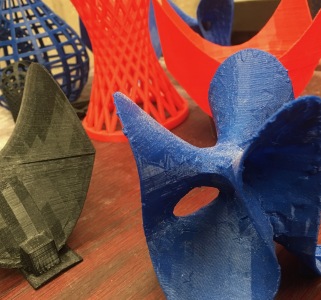Project: Hyperbolic Racquetball

Faculty supervisor: David Dumas
Graduate mentor: Hai Tran
Student researchers: Horalia Armas, Brandon Reichman
Description: The goal of this project is to build a collection of virtual reality experiences to demonstrate features of multiply-connected spaces and hyperbolic geometry (to students, researchers, or anyone else) using the Oculus Rift VR headset and touch controllers. This application will give the user a “first person experience” of different spaces and geometries by allowing them to play a racquetball-like game with infinitely many copies of themselves, arranged according to a periodic tiling of 3-dimensional Euclidean or hyperbolic space.
Outcomes: We created a first person, interactive, virtual reality experience where the player can be inside of different multiply connected spaces. The game was programmed in C# and created with game development software Unity along with the Oculus virtual reality headset and Touch controllers. The majority of the semester was spent creating a racquetball game inside of a three-dimensional torus where the player can see a tiling of them self and hit a ball back and forth with them self. While one of the initial goals of the project was to create this game in hyperbolic space, this was not achieved during the semester’s work; however, the work done during the semester created the necessary framework for hyperbolic space to be implemented in future development.
Materials and resources:
- Poster
- Manifold Ball VR Game, Version 0.2 (requires Windows + Oculus Rift + Oculus Touch):
- Version 0.1: 32-bit / 64-bit
- Manifold Ball Source Code
- Video: Playing ball in the 3-dimensional torus
Project: 3D Printing Surfaces

Faculty supervisor: Daniel Groves
Graduate mentor: Christopher Perez
Student researchers: Alexander Adrahtas, Joel Finlon, Nicholas James
Description: This project is to explore surfaces in three-dimensional space by 3D-printing models of them. The goal is to start by choosing appropriate equations and end with physical models which would be appropriate for use in multivariable calculus classes. This will involve learning about function graphing software, 3D-modeling software and 3D-printing. Time and student interest permitting, we can investigate such things as curvature, ruled surfaces and other things which touch upon ideas from topology, geometry and algebraic geometry.
Outcomes: Our focus for this project was to create multi-variable functions on a 3D printer that could be used to bring into calculus classes. Being three students in Calculus III, we first decided to take a step back and understand the printer technology and how to work with it. As the semester continued, we were able to use more and more aspects of calculus on our prints, and were even able to bring some into our lectures to use as visual aids for the professor.
This project required us to learn how to work with a 3D printer. Our university has an Ultimaker 2 that we used. The Ultimaker 2 requires you to work with software called Cura to make your files printable, and we used other programs such as Blender and SageMath to create these files and make them ready to be sent to Cura.
Materials and resources:
